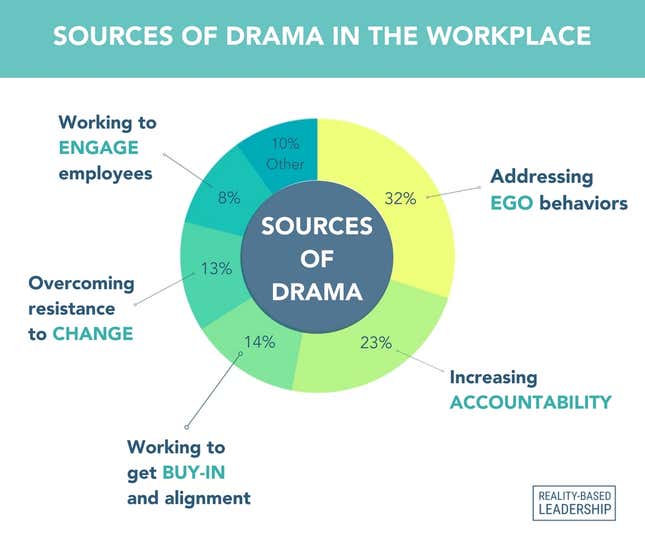Your company is wasting a lot of time on drama—according to my estimate, as much as 2.5 hours per employee every day.
I know what you’re thinking. I speak with leaders from over 200 companies per year, and at almost every event I have, after I share this thought, someone comments: “2.5 hours of drama per employee per day? I just don’t see that in my organization.”
That is because when most people hear the word “drama,” it conjures up pictures of a few highly emotional employees, heated team discussions and arguments, or heated watercooler conversations.
My workplace drama definition includes anything that creates what I call “emotional waste,” mentally wasteful thought processes or unproductive behaviors that keep leaders or their teams from delivering the highest level of results. Drama includes complaining, judging, creating stories, gossiping, blaming, jumping to conclusions, meddling in others’ business, and simply put: arguing with reality.
In 2015, I partnered with the Kantar Futures Company to survey 800 leaders from more than 100 organizations that represent medical, technology, manufacturing and financial organizations about the time that they spend on drama. They reported spending 2.5 hours per day, per employee on drama. And here is what we learned about the percentage of time, per day, leaders were spending dealing with specific non-productive workplace behaviors:

- 32% – Addressing Ego Behaviors. These include your daily, “Got a minute?” conversations, which turn into 45 minutes of employee venting, much of which addresses things that have never happened or never will happen. It’s your time spent exhausted in mitigating workplace gossip, scorekeeping, and the energy invested in soothing employee defensiveness to feedback, resolving hurt feelings and misinterpretations.
- 23% – Increasing accountability. This includes a leader’s time coaching up employees who blame their circumstances (not their efforts) for their lack of results, dealing with lack of ownership for their outcomes and working to improve employee resilience to overcome daily obstacles.
- 14% – Gaining employee buy-in to organizational strategies. Leaders spend tremendous energy managing poor employee attitudes about things that can’t be changed and cajoling for buy-in (which shouldn’t be optional) instead of focusing energy on creating the future.
- 13% – Overcoming resistance to change. Many leaders believe the myth that “change is hard.” Research shows us that change is only hard for the unready. Thus, many leaders are worn out from endless attempts to convince employees to try new approaches and bargaining to get people on board with changes in the organization.
- 8% – Working to engage employees. Engagement, much like happiness, is a choice. Furthermore, I’ve found that accountability, not engagement, drives results. Efforts to engage employees (who are choosing not to be engaged) by using perks creates entitlement.
The work experience is so full of drama that it’s seen as a normal cost of doing business. But I believe drama is both avoidable and has a real negative financial impact. It leads to lost productivity, peace and happiness.
Historically, leaders have been told their role is to inspire, to motivate and engage their teams. But as a therapist, I know from behavioral science that people make their own choices about motivation and inspiration, so for leaders, employee happiness and engagement is an impossible responsibility. I believe the modern leader’s role is to help employees eliminate drama (emotional waste) by facilitating good mental processes. It’s a game-changing approach that relieves leaders of the burden of coming up with all the answers. As these mental processes are hardwired, employees begin to self-manage, become more productive, and as a result, understand the connection to accountable choices, their mindset and the results they deliver.
Two Simple Tools to Start
As you saw in our drama survey results, teams often fall into a collective mindset of “This won’t work. It’s an impossible problem. I don’t like this.” Resistance comes in the form of doomsday predictions or sweeping generalizations. And the game-changing news for you as a leader is that many of these behaviors can be redirected into productivity by using simple tools to shift energy from “why we can’t” into “how we can.” I use two simple tools:
Negative Brainstorming: This is a great exercise for your team when it’s exhibiting resistance or in the “why we can’t” mode. It allows members to express healthy dissent. They can get negative in the first part of the exercise, but eventually, the conversation is redirected in a way that asks them to step up and address the issues constructively. You’ll need a white board or a flipchart.
- First have team members introduce their concerns, one at a time. Capture them on the board or flipchart leaving room to write below each one. Keep writing until everyone’s concerns have been exhausted.
- Label that chart “Risks.” Point out that the team’s value is in its ability to mitigate risks. Ask the team to evaluate each concern or risk based on its probability — low, medium or high. Many of the ones rated “low” are based on fear, or story, and can be eliminated. The heart of the exercise is to have the team create strategies to mitigate every risk labeled “medium” or “high.”
- As team members use their knowledge and expertise to assess each concern/risk, the energy shifts to from “why we can’t” to “how we could.”
Editing Your Story: When an employee stops in for a BMW (blaming, moaning and whining) session, have a notepad handy so you can help people, in the moment, edit their stories. Writing down the facts as people tell their stories also can save time. Here’s an illustration based on an interaction I had with an employee.
Susan had asked for my advice at how to get better at training others. She was scheduled to train a group of workers she wasn’t accustomed to training. I suggested that she ask them for feedback when the training was over. The day after her training session, she came to me in tears. “Well, I took your advice and asked for feedback.” Through her tears, she related that the workers had hated the workshop. They hated the training and they shredded her abilities as a trainer. One guy had stayed for an hour afterward, writing feedback on a piece of paper.
As she spoke, I was writing down only the facts of her story. After she had vented and wept for about 15 minutes, I showed her what I had written.
“I asked for feedback.”
“I received feedback.”
“Now I am crying.”
I asked her, “Are these the facts?” And she began to laugh, because they were.
Everything else was her ego-based story.
Drama is more than visible squabbles and emotional outbursts at work. Workplace drama includes the ego-based resistance to change, employee disengagement and lack of alignment to strategic initiatives – and it is costing companies millions of dollars per year. While there is no lack of leadership and HR training, tools and techniques available, it hasn’t dealt with the root causes of emotional waste. The 2.5 hours per employee per day that workplaces spend on drama adds up to 816 hours per year. Imagine what could be recaptured and created instead.
Cy Wakeman is a Drama Researcher and New York Times Bestselling author. Her latest book is No Ego: How Leaders Can Cut the Cost of Workplace Drama, End Entitlement and Deliver Big Results.
